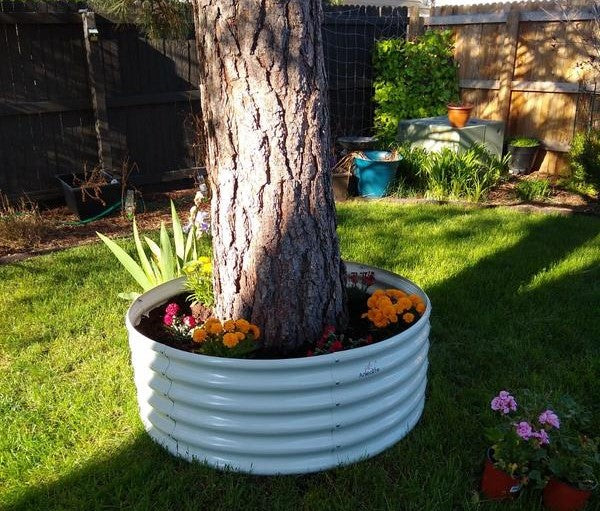Many gardeners love to use raised garden beds because it allows them to have more control over the soil quality, water amount and drainage and prevent soil compaction. It’s easier to keep a garden organized.
But what if adding trees to metal raised garden beds?
Obviously, trees are a bit more complex than planting some tomatoes or an herb garden. Some people argue that it is killing practice to build raised beds around trees, which unfortunately leads to many dead trees. They hold negative opinions based on its fatal impact on root system.
Each tree has a few deep anchoring roots, but the vast majority spread parallel to the soil surface, in the top 18 inches or so of soil. That they occupy this area is no accident—tree roots need oxygen to survive and oxygen is readily available in the top 18 inches of soil. When soil is piled over a root system, it immediately puts the lower roots out of range of their oxygen source. Roots begin to die, starting the tree on a long slow decline and, eventually, to death.
It seems that raising trees in raised beds comes with some challenges, but if done in the right way with the right kind of trees planting trees in raised garden beds can be much beneficial. You just need to make the conditions right and leave the rest to nature.
First, growing your trees in raised garden beds enables you to overcome any natural limitations of your soil. In a raised bed, you can make the perfect soil mixture for whatever type of tree you are planting. Raised beds help keep the soil in place so that it doesn't wash away during flood or become too compacted by heavy equipment.
Another benefit of growing in a raised garden bed is that you can easily control the water supply. Raised beds allow for greater control over how much water each plant receives because you can measure out exactly how much water goes into each section based on its size compared with other sections around it. Since the area is raised, it's easier to reach and give your plants a good spray with the hose if you need to. They provide your trees with smooth drainage and water circulation, which will make sure that your trees stay healthy and strong throughout their life cycle. You can also fertilize and prune at any time without tilling up the soil.
Also, trees planted in metal raised garden beds have fewer weed problems. The soil in a raised bed is easier to control, so weeds are less of an issue. You can also control the pH level by adding lime or fertilizer. With fewer weeds competing for nutrients and water, your trees will grow faster than those planted directly in the soil. This means that once they're established, they'll produce fruit earlier on than their counterparts growing in another type of container or plot setup.
What’s more, there are a few tips to note according to what type of trees you’re planting:
Fruit trees
Take fruit trees for example, your main concern will be poor drainage. With bad drainage, it’s hard to keep a fruit tree living for long. Ideally, your fruit trees will be planted in a raised bed that’s around 10 inches high and 6 feet wide. Of course, if you’re planting something that will grow larger, then you may have to increase the size of the bed. Besides, it’s a great idea to spread mulch on top of the soil where it’s planted to retain moisture.
More pointers are like No Bottoms Necessary – Your raised bed shouldn’t have a bottom if you’re planting fruit trees. It may work for smaller fruit trees depending on how deep your raised beds are, but if it’s too shallow, the roots will be contained in the bed and may not have enough room. This increases the risk of your trees tipping over, which could be a disaster if heavy rains or strong winds come along.
Instead, think about installing a layer of gravel on the ground before you put down your planting mix and fertilizer. The gravel will stop soil from becoming too compacted at the root level, and it will facilitate water drainage.
Also, the way you position your tree when you put it in your garden will make a big difference. Put the sapling in and stand it as straight as possible to prevent it from leaning over or favoring one direction.
Ornamental trees
When it comes to ornamental trees in raised beds things could be somewhat different. If you’re considering a tree like white fir, eastern redbud, or a Japanese lilac tree, planting them in a raised bed is the way to go.
It’s a more sure way to ensure proper drainage. If your soil is too saturated with water, then they’ll struggle. You had better guarantee there is always a top layer of fertile soil that will drain out excess water from a hose, sprinklers, or the rain.
Dwarf trees
People who don’t have a ton of space on their property can enjoy the benefits of a fruit tree or ornamental trees by planting dwarf varieties.
Sure, you won’t get as much fruit during harvest time, but you still get that wonderful feeling of seeing your plant thrive.
A typical dwarf tree will grow to around 9 feet tall, while a full-size tree can grow much larger. If you’re planting full-size trees, you’re going to need larger raised beds to accommodate root growth and handle drainage for the extra water you’ll be giving it.




